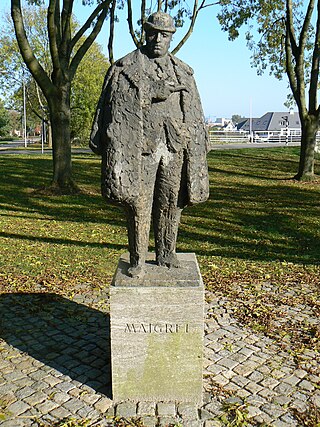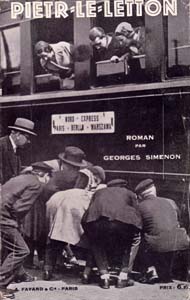
Jules Maigret, or simply Maigret, is a fictional French police detective, a commissaire ("commissioner") of the Paris Brigade Criminelle, created by writer Georges Simenon. The character's full name is Jules Amédée François Maigret.

Georges Joseph Christian Simenon was a Belgian writer, most famous for his fictional detective Jules Maigret. One of the most popular authors of the 20th century, he published around 400 novels, 21 volumes of memoirs and many short stories, selling over 500 million copies.
The police procedural, police show, or police crime drama is a subgenre of procedural drama and detective fiction that emphasises the investigative procedure of police officers, police detectives, or law enforcement agencies as the protagonists, as contrasted with other genres that focus on non-police investigators such as private investigators.

The Strange Case of Peter the Lett is a 1931 detective novel by the Belgian writer Georges Simenon. It is the first novel to feature Inspector Jules Maigret who would later appear in more than a hundred stories by Simenon and who has become a legendary figure in the annals of detective fiction.

Maigret is a British television series made by the BBC and which – following a pilot episode broadcast in 1959 – ran for 52 episodes from 1960 to 1963.

Le Coup de Lune (; literally "moonburn" or "moonstroke" in French, but translated into English as Tropic Moon, is a 1933 novel by Belgian writer Georges Simenon. It is one of the author's first self-described roman durs or "hard novels" to distinguish it from his romans populaires or "popular novels," which are primarily mysteries that usually feature his famous Inspector Maigret character.

Les Fiançailles de M. Hire is a short novel by Belgian writer Georges Simenon. It is one of the author's first self-described roman durs or "hard novels" to distinguish it from his romans populaires or "popular novels," which are primarily mysteries that usually feature his famous Inspector Maigret character.
Patrick Marnham is an English writer, journalist and biographer. He was elected as a Fellow of the Royal Society Literature in 1988. He is primarily known for his travel writing and for his biographies, where he has covered subjects as diverse as Diego Rivera, Georges Simenon, Jean Moulin and Mary Wesley. His most recent book, published in September 2020, is War in the Shadows: Resistance, Deception and Betrayal in Occupied France, an investigation into the betrayal of a British resistance network in the summer of 1943.

Maigret and Monsieur Charles is a detective novel by the Belgian writer Georges Simenon, and is the last novel featuring his long-running character Jules Maigret.

A Battle of Nerves is a detective novel by Belgian writer Georges Simenon, featuring his character Inspector Jules Maigret. Published in 1931, it is one of the earliest of Simenon's "Maigret" novels, and one of eleven he had published that year.

Maigret's Revolver is a novel by the Belgian writer Georges Simenon. The original French version Le Revolver de Maigret appeared in 1952. The theft of Inspector Jules Maigret's revolver from his home begins a detective story that leads to Maigret travelling from Paris to London to find the young man who stole it, and the woman who is in danger of being his victim.

The Crime of Inspector Maigret is a novel by the Belgian writer Georges Simenon. The original French-language version Le Pendu de Saint-Pholien appeared in 1931: it is one of the earliest novels by Simenon featuring the detective Jules Maigret.

Maigret's Dead Man, also translated as Maigret and His Dead Man and Maigret’s Special Murder, is a 1948 detective novel by the Belgian novelist Georges Simenon featuring the fictional character Jules Maigret. It was Simenon's 29th Maigret novel.

Lettre à mon juge was written by Belgian author Georges Simenon in 1946 during his stay at Bradenton Beach, Florida and published in Paris the following year by Presses de la Cité. It is a dark psychological account of a man overcome by buried passions who becomes a murderer.
Maigret is a 1988 television film starring Richard Harris as Georges Simenon's detective, Jules Maigret. The film was intended as a pilot for a potential television series.

Georges Joseph Christian Simenon was a Belgian writer, most famous for his fictional detective Jules Maigret. He was one of the most popular authors of the 20th century, selling over 500 million copies of his works during his lifetime. Apart from his detective fiction, he achieved critical acclaim for his literary novels which he called romans durs. Among his literary admirers were Max Jacob, François Mauriac and André Gide. Gide wrote, “I consider Simenon a great novelist, the greatest perhaps, and the most truly a novelist that we have had in contemporary French literature.”

Le Cercle des Mahé (1946), translated as The Mahé Circle, is a novel by Belgian writer Georges Simenon; it is one of the author's self-described roman durs or "hard novels" to distinguish it from his romans populaires or "popular novels," which are primarily mysteries that usually feature his famous Inspector Maigret character.

La Cage de verre (1971), translated as The Glass Cage, is a novel by Georges Simenon; it is one of the author's self-described roman durs or "hard novels" to distinguish it from his romans populaires or "popular novels," which are primarily mysteries that usually feature his famous Inspector Maigret character.

La disparition d'Odile is a novel by Belgian writer Georges Simenon; it is one of the author's self-described roman durs, or more literary "hard novels," to distinguish it from his romans populaires or "popular novels," which are primarily mysteries that usually feature his famous Inspector Maigret character.
Les noces de Poitiers (1946), translated as The Couple from Poitiers, is a novel by Belgian writer Georges Simenon; it is one of the author's self-described roman durs or "hard novels" to distinguish it from his romans populaires or "popular novels," which are primarily mysteries that usually feature his famous Inspector Maigret character.
















